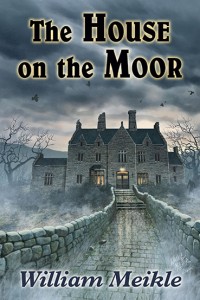
William Meikle
Dark Renaissance Books
November 20, 2015
Reviewed by Michael R. Collings
In The House on the Moor, an entry in Dark Renaissance Books’ Haunted House novella series, William Meikle provides all of the elements for an effective classical haunting.
The first, and perhaps most important, is an isolated landscape; and what better place than the Scottish moors in March, damp, foggy, chilly, and inherently foreboding. And set in the middle of the moor, miles from anywhere or anyone, a mansion, an ancient pile of gray granite as cold and forbidding as the landscape.
The second requirement calls for mysterious characters. John and Carole Fraser are not necessarily mysterious, but they provide a pivotal tension. John intends to interview an old friend of his grandfather’s, the owner of the house, searching for a key to his grandfather’s cryptic death that will provide him with material for the bestselling biography he hopes to write. Carole, on the other hand, is frustrated with the prospect of a weekend wasted in the rain, the cold, and the barrenness. Before the weekend even starts, she is angry with John and wants only to leave.
Upon arriving at the house on the moor, the Frasers meet David Blacklaw, who seems as ancient as the house itself: aged, frail, clearly wanting to reveal a long-kept secret but nearly lacking the strength to do so. The only others living in the house—well, the only humans, at any rate—are the McKinnons, old family retainers as fragile and enigmatic as the “Maister” himself.
The third element: a ghost. Or ghosts. Or, more specifically in The House on the Moor, something eerie, initially unseen but heard, manifesting itself in scratches emanating at night from the upper reaches of the vast, three-story library. Or something seen but not understood, like the hunched, grey shadow of a man that appears and disappears on the lonely moors outside the house.
And a fourth element: a secret buried in the past, tantalizing to the young couple, distressing to Blacklaw, and threatening to all of them. In this case, the apparent secret is revealed early in the book: some five decades earlier, David Blacklaw and Hugh Fraser had been celebrities, personalities famous for being famous. Some years later, as their notoriety began to wane, Fraser had discovered an antique tome in an old bookstore and, using one of the rituals in the book, decided to stage—and film—a ritual calling on supernatural powers. At the end, he and Blacklaw would reveal that the whole rigamarole was faked, that the supernatural did not exist. With any luck, Fraser explained, the film would provide the first episode in a supernatural-busters-style television series.
Fraser had thought everything through, except the possibility that the archaic chant might actually work.
Now John and Carole, Blacklaw, and the McKinnons must face terror and an unimaginable menace to put a stop to what Hugh Fraser began.
Meikle handles his story well. He paces the narrative—its revelations and its suspense—carefully, allowing each of his four main characters opportunities to move the story toward its conclusion (Mrs. McKinnon stays mostly in the kitchen). He makes full use of the elements he has brought together, particularly the moors and the house itself. Gradually, even as John and Carole grow closer, they are bound more deeply to the house as they penetrate its secrets; they understand more about the consequence of John’s obsessive need to know every detail about his grandfather’s death; and, together, they discover how the house, the ghosts (if I may use a generalized word), and the long-kept secret will alter their lives.
Highly recommended.
- Killing Time – Book Review - February 6, 2018
- The Cthulhu Casebooks: Sherlock Holmes and the Miskatonic Monstrosities – Book Review - January 19, 2018
- The Best Horror of the Year, Volume Nine – Book Review - December 19, 2017
- Widow’s Point – Book Review - December 14, 2017
- Sharkantula – Book Review - November 8, 2017
- Cthulhu Deep Down Under – Book Review - October 31, 2017
- When the Night Owl Screams – Book Review - October 30, 2017
- Leviathan: Ghost Rig – Book Review - September 29, 2017
- Cthulhu Blues – Book Review - September 20, 2017
- Snaked: Deep Sea Rising – Book Review - September 4, 2017


